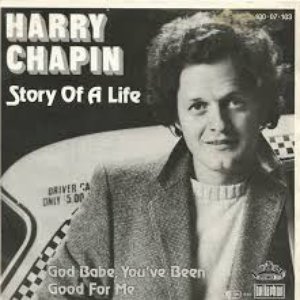Published on Nov 5, 1999
I think I’ve told the story several times on this site about how
I got into Harry Chapin. My mom woke me up the morning of my dad’s
birthday when I was about four years old, and took me to the stereo
in the living room. Quietly, she played the 45 of “Cat’s In The
Cradle” for me, and told me this would be my birthday gift to my
dad. That moment was the start of a love affair with Chapin’s
music.
Ah, but it was a fickle affair. How many of us can honestly name
more than five songs of Chapin’s without consulting the album
jackets? I can – but not by much. Besides my ruining my dad’s copy
of
Dance Band On The Titanic and occasionally hearing “Taxi” on
the radio, I really didn’t get that deep into Chapin’s music, save
for “Cat’s In The Cradle”. And, when Chapin died in a car crash in
1981, I was sad, but I didn’t quite understand the
significance.
For all of us,
Story Of A Life, a three-CD box set chronicling Chapin’s
life and work, is the musical equivalent of the GED. It’s a lot to
stomach in one sitting, but it provides a fair portrait of the man
and his music, both good and bad.
This set does one thing that is excellent right off the bat: the
music is presented in chronological order, so you can hear the
growth of Chapin the musician as the set progresses. (Actually,
that’s not entirely true; the second cut of the set is really the
earliest number, but after that, it proceeds smoothly.) Smart move
number two is opening the set with “Taxi,” Chapin’s first brush
with fame, instead of the earlier cut “Someone Keeps Calling My
Name” – and makes the musical flip-flop forgivable.
Chapin’s magic is heard early on, not just in songs like “Taxi,”
but in some of the less heralded tracks like “Better Place To Be,”
“They Call Her Easy” and “Mr. Tanner,” all of which embody the
“story-song” image that Chapin had throughout his career. One
track, “Sniper,” is a song that will take more than one listen to
truly appreciate (as well as a lot of time, seeing it clocks in at
over nine minutes), but will prove to be well worth the effort.
Even in all this early glory, some cracks in the ceiling can be
seen. Cuts like “Sunday Morning Sunshine” and “W*O*L*D*” just
didn’t do anything for me, no matter how many times I listened to
them. While this shows that Chapin could be hit-or-miss in his
music, the set as a whole suggests that Chapin more often hit the
musical target.
The second disc contains “Cat’s In The Cradle,” which is still
an amazing song 25 years after it came out. But this portion of
Story Of A Life also contains some of the more tentative
moments of Chapin’s career. For every song like “I Wanna Learn A
Love Song,” “30,000 Pounds Of Bananas” and “The Mayor Of Candor
Lied,” there are less secure musical moments like “What Made
America Famous,” “Dreams Go By” and “Vacancy”. The crowning moment
for me, surprisingly, isn’t “Cat’s In The Cradle,” but rather a
live version of “Taxi” that shows Chapin’s oneness with his
audience.
The third and final disc contains some tracks that might be
among some of Chapin’s least acclaimed critically, but they’re well
worth your time. “Dance Band On The Titanic” painted a picture of
the experience on the infamous boat 20 years before James Cameron
could have envisioned his film, and is a decent track. (Side note:
Why weren’t tracks like “We Grew Up A Little Bit” or “My Old Lady”
selected? I happen to like these over “Mismatch,” though this track
proves its mettle as well.) Likewise, songs like “Corey’s Coming”
and “Dancing Boy” will make one question why Chapin wasn’t a bigger
star in his time.
Near the end of his life, though, Chapin’s music began to weaken
a bit. His vocals started to warble more, to the point where he
sounded a little like Ethel Merman at times on “November Rains” and
“Story Of A Life”. And while people wanted to know whatever
happened to the characters in the song “Taxi,” I don’t think that
continuing the story on “Sequel” was the right idea; such a story
is best completed in one’s own mind. Besides, it’s been my life’s
experiences that the reunions of “what-if”s never happens.
Compared to some of his stylistic contemporaries like John
Denver and, to an extent, Bob Dylan, Chapin got the short end of
the stick in his career. He was as talented a songwriter and
musician, but he rarely scored a hit (and never another one along
the lines of “Cat’s In The Cradle”). This, as we say in the
business, is a God-Damn Shame. .. but in a sense, Chapin’s true
success lay not in his music, but in his humanitarian efforts,
including his fight to stop world hunger.
Story Of A Life is the kind of collection that will not only
remind you how great of an artist Chapin could be, but will
probably get you digging through your record collections and
dusting off albums like
Heads & Tales and
Verities And Balderdash to re-discover for the first time
what we’ve been missing all these years.
